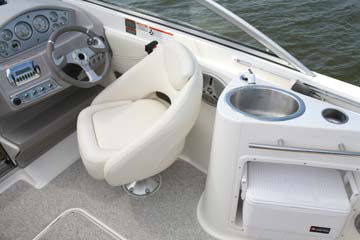Maxum 2100 SC3 for Cuddy Lovers
Believe it or not, 86% of the runabouts sold these days are bowriders. They have lots of room for passengers and kids love
them. Nevertheless, we still have a fond spot in our institutional heart for the
traditional cuddy cabin runabout. Maxum has managed to capture some of the elegance,
style and class of the old cuddies with their 2100 SC3. We think the Maxum designers
have done a good job of styling a modern boat, yet one that remembers its traditional
roots. Just look at that picture below. Note the beautiful black hull (no Clorox
bottle here), teak swim platform, the graceful bustle in the stern curving down to an ever-so-modern seat on the transom.
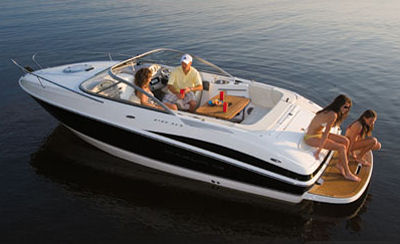 It is the traditional sportboat design, and we still love the looks of a cuddy. |
Usually we put the price of the boats we review at the end of the article because
it seems a bit crass to plop it into the first paragraph of a review. But in fact, we always ask the salesman the price before we look at a boat, or a car or a house
or most
anything else. It doesn’t have to be the “last” price, MSRP will do. Price
puts the boat into context. Is it a high price, low price or somewhere in the middle?
If the price of the boat is low compared to her peers in class, then we subdue our
expectations and find that we can more easily forgive the absence of many amenities.
And while we always expect the important aspect of the boat to be constructed correctly
and the boat to be seaworthy no matter how low the price, there are many details
about a boat that are “nice to have” but frankly, they just drive up the price.
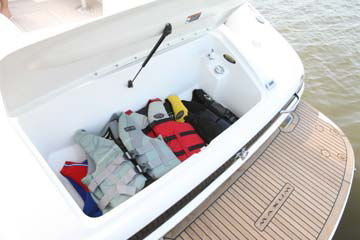
Maxum designer have created a huge amount of
storage space for watersports ear right where it should be – by the swim platform.
When getting on a boat that is at the high end of the price spectrum, we expect
everything to not only be done right, but be done with the best materials available
and be accompanied with customer service found only at places like the Ritz-Carlton
in Naples, Florida (where all American employees are trained in Old World European
service).
The Price
The MSRP of the Maxum 2100SC3 is $39,719 with the standard engine which is the 220-hp
4.3L MPI Alpha I MerCruiser. (If you
were born yesterday, MSRP in the boat business
means you can actually buy the boat for somewhat less.)
So where does Maxum fall in the overall plot of boat pricing? We think the best
answer to that question can come from BoatTEST.com Maxum owners who have taken the
time to provide our readers and researchers with their opinions of Maxum products.
Maxum Owner Reviews
If you have not taken the time to read over BoatTEST’s “Owner Reviews” that accompany
most boat tests, we urge you to do so, as it will be an exercise in seeing expectations
met or disappointed.
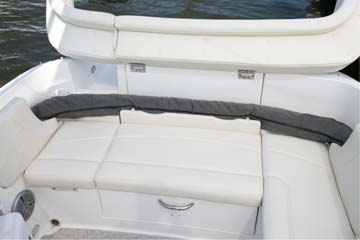
The convertible top hides completely out of
the way behind the seat backs in the stern of the boat.
Great Expectations
There are 18 Maxum owner reports posted. Interestingly, there is not an irate customer
in the lot. This is a bit unusual, as generally no matter what the brand, there
is someone who is out of sorts. This indicates to us that customers’ expectations
are being met by the Maxum products. A thread that ran through a number of the reviews
was that of “value.” The owner of a 3000SRC said his boat was “one of the best dollar
values in today’s market.” The owner of a 35 said that “This is a very under-rated
boat.” The owner of an 1800SR3 said his boat was a “great value.”
The owner of a 25 said his boat “Handled better than I expected the first time I
found myself in 5’ to 6’ seas.”
Maxums are not at the low end of the price-point scale and if our reading of the
Maxum owners’ perceptions is correct, the company has found the sweet spot of quality,
amenities and price and has met its customers’ expectations.
Power for the Glory
A second theme we found in some of these 18 reviews, as well as in those for many
other brands: boats being under-powered. For example, the owner of a 1800 said his
boat was “OK for my needs, but for skiing it needs more power.” He had a boat with
the 3.0L 135-hp engine.
A 2500 SR owner said “Underpowered with the 260-hp Mercury, runs great with the
300-hp PCM repower.”
An owner of an 1800 SR3 said his “Boat runs great with 190-hp
– I recommend.”
Performance vs. Application
Maxum has done a good job of filling its customer in on the basic performance characteristics
of the 2100 SR3. It says that with full tanks and four people aboard and appropriate
gear, the boat has a WOT of 44.5 mph and a best cruise of 32.3 mph with the 4.3L
MPI Alpha I 220-hp engine. Maxum does not tell us what the time to plane is or the
0 to 30 time, so if you are planning on skiing or wakeboarding you’ll need to investigate
this further.
(Please note: BoatTEST.com has not tested the 2100 SR3 so we can make no judgment
on performance, boat handling, or other aspects of the boat, nor can we provide
you with independent 3rd party test data.)
Maxum offers both a 260-hp option and a 300-hp option for the boat. The 260-hp 5.0L
Mercury costs an extra $2,243 and the 350 MAG MPI with 300-hp boosts the price $4,636.
We recommend that you check out the performance tables under the engine section
on BoatTEST.com for the three engines involved, in order to get a better handle on
which engine would be best for your application.
Please note that Maxum also offers a 1.7L diesel engine rated at 120-hp. While its
speed is predictably less than with the gas engines, Maxum reports that it gives
the boat a range of 327 miles using 90% of the fuel capacity. While Americans might
not be interested in such capabilities, boat buyers around the world may well give
this option serious consideration.
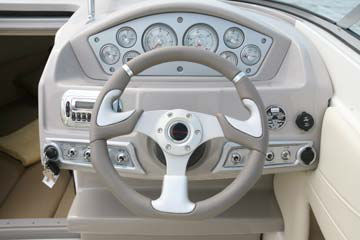
The 2100 SR3 has a well-designed instrument
panel.
Height of Eye
Another theme that runs through many owners’ reports of runabout boats is the difficulty
of finding a seat that is the “right” height. The 5’10” owner of an 1800 said “…the
helm seat needs to be higher.” The owner of an 1800 SR3 who complained that he could
not stand at the helm because the seat was “…too far forward” praised the seat for
being just the “right height.”
In this regard, we note that on the 2100 SC3 the helm seat swivels, slides fore
and aft and can be adjusted vertically! Hooray! We have been urging builders to
do just this for years, and full marks to Maxum for doing it.
Fit and Finish
Now we come to expectations, both met and unmet.
The owner of an 1800 SR3 said “Overall Maxum is a great product, however some of
the workmanship and quality are disappointing.” The owner of a 1900 SR3 agreed saying
“A little disappointed with the finishing touches on the boat. Could have been better.”
Then he added, “..would recommend [the ![]() to anyone looking for a good overall
to anyone looking for a good overall
boat.”
So there you have our boiled-down version of the most notable owner comments we
have received on Maxum boats. To read the un-edited versions yourself,
click here.
High Points of the 2100 SR3
In going over the specifications of the 2100 and the list of standard equipment,
we found a few things we’d like to point out.
As standard equipment the boat has
courtesy lights in the cockpit, a convertible top with boot, an alarm for high engine
water temperature, a non-glare dash in front of the helm, a remote oil drain for
the engine, stainless steel thru-hull fittings, and a rigid rub rail with a stainless
steel insert. These are all important items.
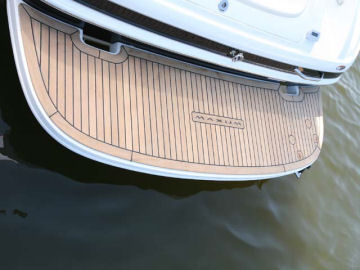 A great safety feature: note that the swim platform extends beyond the lower unit. |
Probably the standard item we like the most is the extended swim platform. Maxum
has done a good job of this feature, extending it beyond the stern drive lower unit
so that when swimmers slide into the water they won’t cut their foot on the prop
(which, of course, is always turned off when people are in the water nearby).
